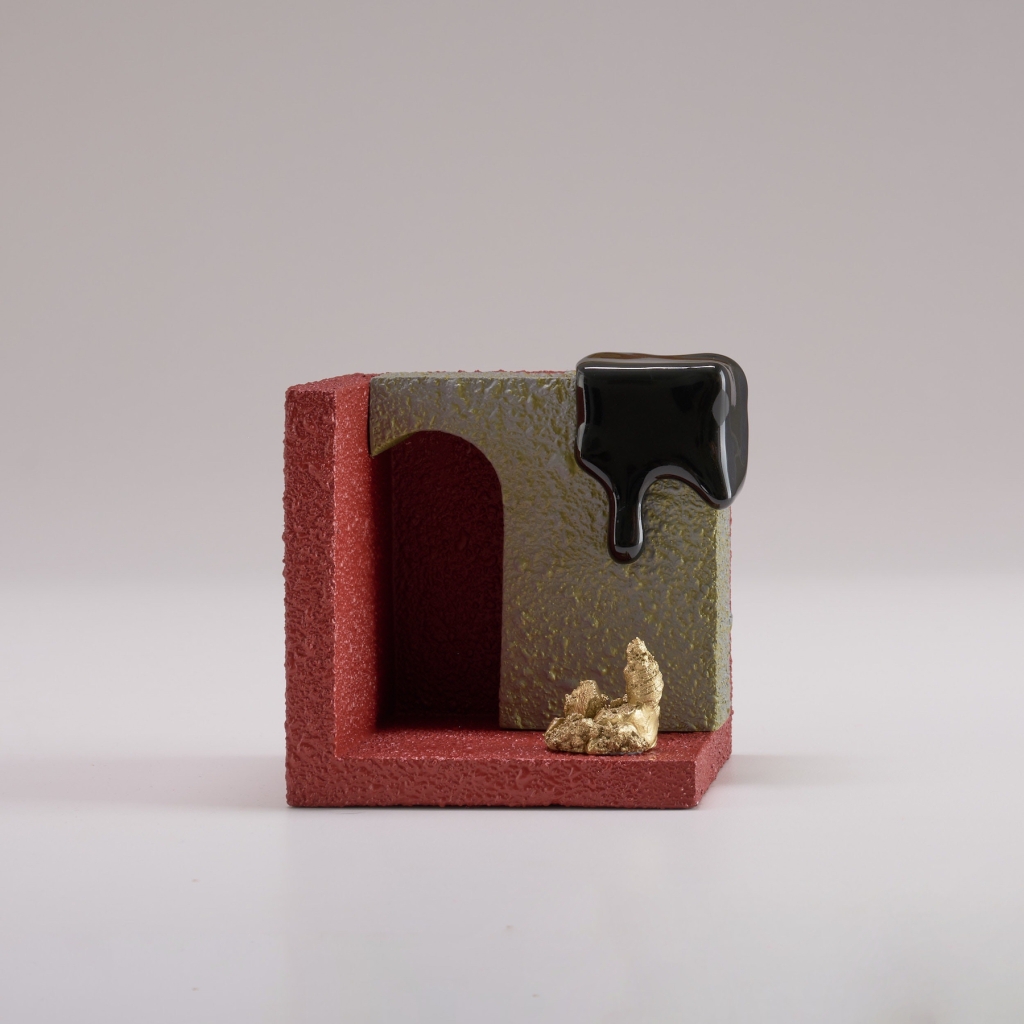 Ron Nagle, Curtain of Oblivion, 2021. Ceramic, glaze, catalyzed polyurethane, and epoxy resin. Photography: William Pruyn. Copyright © Ron Nagle, courtesy Matthew Marks Gallery.
Ron Nagle, Curtain of Oblivion, 2021. Ceramic, glaze, catalyzed polyurethane, and epoxy resin. Photography: William Pruyn. Copyright © Ron Nagle, courtesy Matthew Marks Gallery.
Although Ron Nagle has been among the best-known ceramic artists of the past six decades, the subject of clay technique seems to make him a bit cranky. “I don’t mind talking about the creative process,” he says, “but not when it’s limited to how did you achieve this or that effect, or let’s have a raku party. I mean, that’s all bullshit to me.”
Of course, anyone looking at his work and its exquisite balance of color, surface, and contour can see he’s a master craftsman. Still, his skepticism comes honestly. During the 1960s and ’70s, the Bay Area native, now 82, was part of a group of innovative West Coast artists who pushed the boundaries of ceramics both technically and aesthetically. They broke with the idea of relegating clay to secondary status, insisting that it was the equal of paint or any other medium of artistic expression. It was tough going for a while, Nagle notes, but things have changed. “It took 60 years. I would be making something, and somebody would say, ‘What are you doing making that? That’s not sculpture.’ Now all of a sudden, every gallery is showing ceramics.”
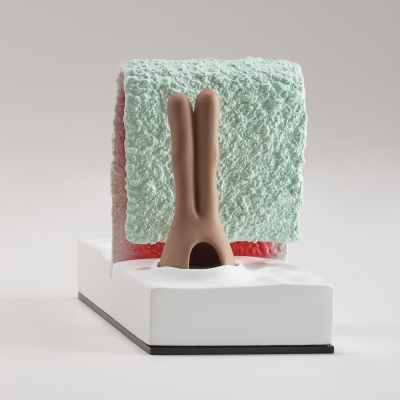 Ron Nagle, The Whisperer, 2021. Ceramic, catalyzed polyurethane, epoxy resin, and acrylic, 4 3/8 x 3 3/4 x 3 3/4 inches. Photography: William Pruyn. Copyright © Ron Nagle, courtesy Matthew Marks Gallery.
Ron Nagle, The Whisperer, 2021. Ceramic, catalyzed polyurethane, epoxy resin, and acrylic, 4 3/8 x 3 3/4 x 3 3/4 inches. Photography: William Pruyn. Copyright © Ron Nagle, courtesy Matthew Marks Gallery.
That would include Matthew Marks in New York, where Nagle’s latest exhibition is up until October 23. Titled “Necessary Obstacles” (a phrase that Nagle admits has no particular meaning but may have resulted from “watching too much political TV in the last couple of years”), the show features 18 new sculptures in his signature style: compact objects combining geometric and organic forms into gnomic ensembles that escape easy description. They recall buildings and landscapes all at once. “They’ve got sort of this inside/outside quality,” Nagle says. “I always like the mystery of looking inside something in this kind of intimate observation, where you can see what’s going on, but then there’s also something beyond.” Nagle possesses a unique talent for leveraging grandeur from a small package—a quality enhanced by installing the work in large Plexiglas vitrines, giving viewers the sense that each Lilliputian piece could suddenly, unexpectedly expand. “They allude to a bigger scale without being large-scale,” Nagel explains. “Very small objects have always intrigued me. The first experience I ever had actually making stuff was as a kid building model airplanes.”
The exhibit also includes six studies on paper. As much as Nagel prefers not to dwell on it, his process starts with preparatory sketches derived from observation. “If something catches my attention, whether it’s a tree branch or bird shit on the sidewalk, I’ll take a picture of it or store it away in my memory.” The drawings, he adds, are only an inch and a half at most. “Some of them stand alone, but mostly they’re just quick notations of what I’m thinking about or seeing.” Next, he determines size with the help of a copy machine. “It’s one of my favorite tools,” he says. “I use it to blow the drawings up until they feel right.” He then makes a maquette before the final decision. “I may think, ‘God, that looks too big,’ so I’ll diminish it by an inch or widen a certain area.”
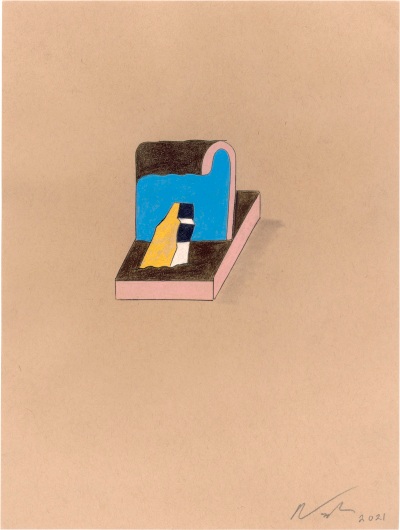 Ron Nagle, Untitled, 2021. Ink, acrylic, colored pencil, and graphite on craft paper, 12 x 9 inches. Photography: William Pruyn. Copyright © Ron Nagle, courtesy Matthew Marks Gallery.
Ron Nagle, Untitled, 2021. Ink, acrylic, colored pencil, and graphite on craft paper, 12 x 9 inches. Photography: William Pruyn. Copyright © Ron Nagle, courtesy Matthew Marks Gallery.
Although Nagle employs traditional ceramic methods such as slab building, glazing, and slip-casting (pouring liquid clay into a mold), he also introduces unorthodox ingredients—catalyzed polyurethane, epoxy resin, acrylic—into the mix. A prime example of his approach, Curtain of Oblivion (2012), features rectangular components—one with an enigmatic arched doorway—joined to create something like a miniature stage set that’s been sawed in half and airbrushed with auto-body paint. Most of Curtain is covered with a stucco surface that, according to Nagle, was typically found on the homes where he grew up. (“I hated them as a kid,” he says. “I’d tell people I wanted to live in a Victorian house. Now I detest Victorian architecture.”)
In almost all of his efforts, Nagle contrasts rough textures with smooth, glazed elements; in Curtain, it is a large a black drip on the top right corner. “Glaze has a depth that you can’t get with paint,” Nagle notes, before describing the drip’s dark sheen as “spooky.” He adds, “I’m very big on spookiness. Also, melancholy.” Curtain’s final touch is a gilded bit of scrap material. “I decided it looked good. Don’t ask me why.”
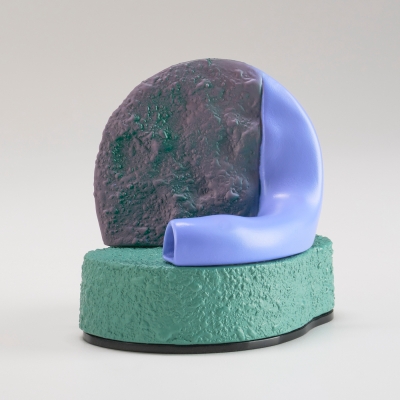 Ron Nagle, Offline Connection, 2021. Ceramic, catalyzed polyurethane, epoxy resin, acrylic, 4 x 3 x 4 1/2 inches. Photography: William Pruyn. Copyright © Ron Nagle, courtesy Matthew Marks Gallery.
Ron Nagle, Offline Connection, 2021. Ceramic, catalyzed polyurethane, epoxy resin, acrylic, 4 x 3 x 4 1/2 inches. Photography: William Pruyn. Copyright © Ron Nagle, courtesy Matthew Marks Gallery.
Curtain also exemplifies the eclectic range of Nagle’s influences, which include Giorgio Morandi, Philip Guston, and the Mexican architect Luis Barragán, whose presence is particularly felt in Curtain’s iridescent palette of russet and olive green. For Nagle, color is as important as form. “I think of these things as three-dimensional paintings, really.”
Meanwhile, the pigment Nagle uses evokes 1960s California car culture, for which he has a strong affinity. He mentions his fascination with low riders: “Some of them have colors that are fabulous, like nothing a painter would come up with.”
Additionally, Nagle has a personal relationship with the Bay Area’s pop history: He was in a R&B band at the start of the hippie era, playing at the legendary Fillmore with groups like the Grateful Dead (whose name he can’t mention “without starting to gag”). As with a lot of other things, Nagle wasn’t especially fond of the flower child milieu. “I had a great deal of distaste for the visual trappings of what became the Summer of Love. Light shows, tie-dye—I hated all that stuff.”
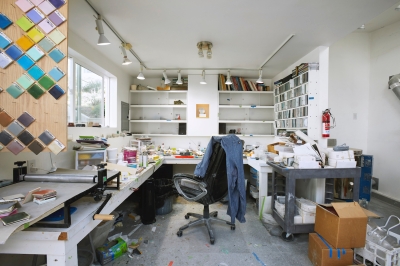 Ron Nagle’s studio in San Francisco. Photography: William Pruyn. Courtesy Matthew Marks Gallery.
Ron Nagle’s studio in San Francisco. Photography: William Pruyn. Courtesy Matthew Marks Gallery.
Still, a certain countercultural subversion percolates through Nagle’s art, though not necessarily one derived from dropping acid. Rather, he cites George Herriman as a major inspiration. Herriman, an African-American cartoonist from New Orleans, was best known as the creator of Krazy Kat, a comic strip that ran in the New York World and other newspapers during the first half of the 20th century. Krazy Kat (celebrated by contemporary critics for its sly twists on gender, race, and authority) unfolds in the fictional realm of KoKo Land, a proto-psychedelic landscape dotted with surreal structures—a setting, in other words, where Curtain of Oblivion would fit right in. Ultimately Nagle doesn’t make grand claims for his work. While he admits that lately it seems to have taken on a narrative cast, it’s incidental to his point that’s there’s no real point—other than perhaps the doing. “It’s all pretty intuitive,” he says. “I wouldn’t go so far as to say that working for me is meditative, but it’s the only thing keeping me sane right now.”
Source link : https://www.artnews.com/art-news/artists/ron-nagle-new-ceramic-sculptures-2021-1234605238












